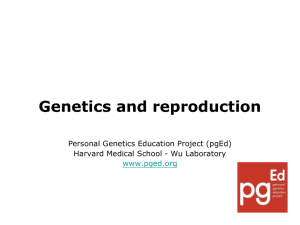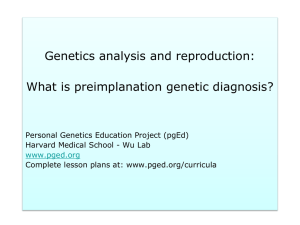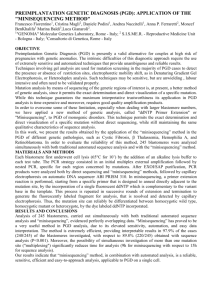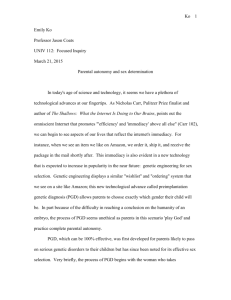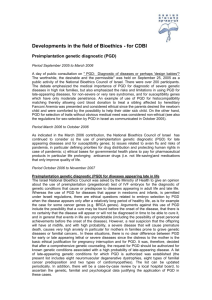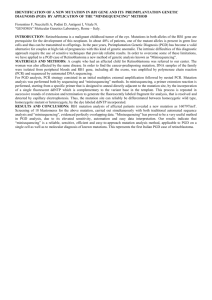what the future holds
advertisement
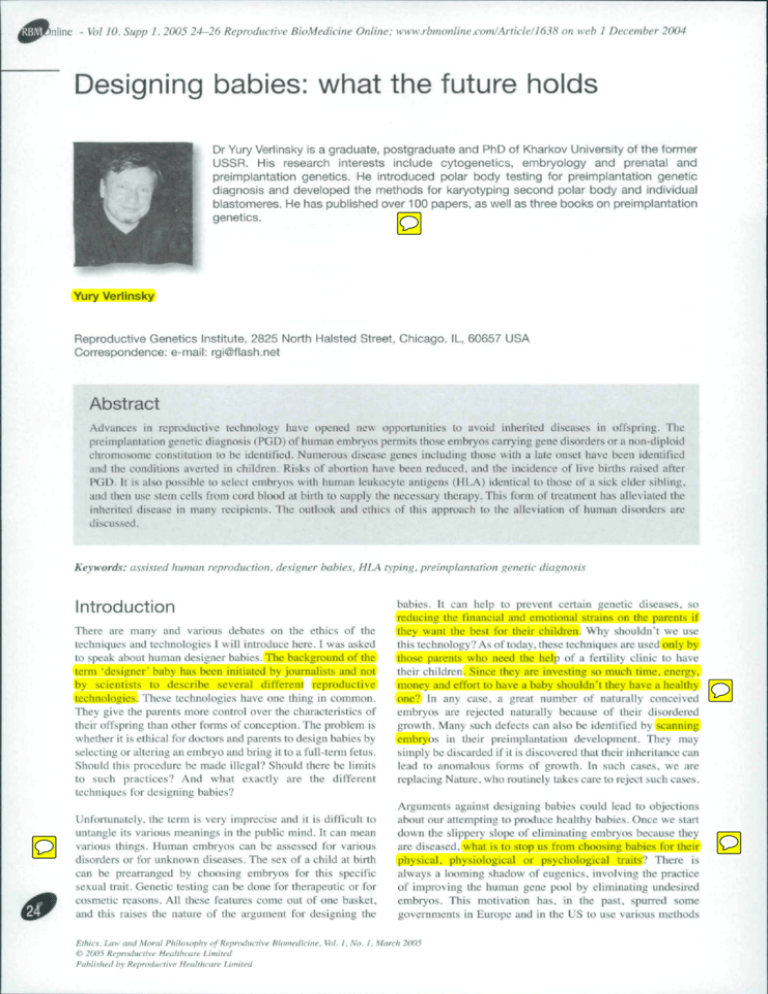
- Vol 10, Supp I. 2005 24-26 Reproductive BioMedicine Online: www.rbmonline.com/Article/1638 on web I December 2004 Designing babies: what the future holds Dr Yury Verlinsky is a graduate, postgraduate and PhD ot Kharkov University of the tormer USSR, His research interests include cytogenetics, embryology and prenatal and preimpiantation genetics. He introduced polar body testing for preimpiantation genetic diagnosis and developed the methods for karyotyping second polar body and individual blastomeres. He has published over 100 papers, as well as three books on preimpiantation genetics. Yury Verlinsky Reproductive Genetics Institute, 2825 North Halsted Street, Chicago, IL, 60657 USA Correspondence: e-mail: rgi@flash.net Abstract Advances in reproductive technology have opened new opportunities to avoid inherited diseases in offspring. The preimpiantation genetic diagnosis (PGD) of human embryos permits those embryos carrying gene disorders or a non-diploid chromosome con,stilution to be identified. Numerous disease genes including those with a late onset have been identified and the conditions averted in children. Risks of abortion have been reduced, and the incidence of live births raised after PGD. It is also possible to select embryos with human leukocyte antigens (HLA) identical to those of a sick elder sibling. and then use stem cells from cord blood at birtli to supply the necessary therapy. This form of treatment has alleviated the inherited disease in many recipients. The outlook and ethics of this approach to the alleviation of human disorders are discussed. Keywords: assisted human reproduction, designer babies, HLA typing, preimpiantation genetic diagnosis Introduction There are many and various debates on the ethics of the techniques and technologies I will introduce here, 1 was asked to speak about human designer babies. The background of the term "designer" baby has t?een initiated by journalists and not by scientists to describe several different reproductive technologies. These technologies have one thing in common. They give the parents more control over the characteristics of their offspring than other forms of conception. The problem is whether it is ethical for doctors and parents to design babies by selecting or altering an embryo and bring it to a full-term fetus. Should this procedure be made illegal? Should there be limits to such practices? And what exactly are the different techniques for designing babie.s? Unfortunately, the term is very imprecise and it is diffieult to untangle its various meanings in the public mind. It can mean various things. Human embryos can be assessed for various disorders or for unknown diseases. The sex of a child at birth can be prearranged by choosing embryos for this specific sexual trait. Genetic testing ean be done for therapeutic or for cosmetic reasons. All these features come out of one basket. and this raises the nature of the argument for designing the babies, it can help to prevent certain genetic diseases, so reducing the financial and emotional strains on the parents if they want the best for their children. Why shouldn't we use this technology? As of today, these techniques are used only by those parents who need the help of a fertility clinic to have their children. Since they are investing so much time, energy, money and effort to have a baby shouldn't they have a healthy one? In any case, a great number of naturally conceived embryos are rejected naturally because of their disordered growth. Many such defects can also be identified by scanning embryos in their preimpiantation development. They may simply be discarded if it is discovered that their inheritance can lead to anomalous forms of growth. In such cases, we are replacing Nature, who routinely takes care to reject such cases. Argurnents against designing babies could lead to objections about our attempting to produce healthy babies. Once we start down the slippery slope of eliminating embryos because they are diseased, whal is to stop us from choosing babies for their physical, physiological or psychological traits? There is always a looming shadow of eugenics, involving the practice of improving the human gene pool by eliminating undesired embryos. This motivation has. in the past, spurred some governments in Europe and in the US to use various methods Ethics. Law and Moral Philosophy of Reproductive Bionietlicine. Vol. I. No. I. March 2tXI5 © 2005 Rcpri'diiciivc Healthcare Limited Published by Reproductive Healthcare Limited Ethics - Designing babies - ¥ Verlinsky sueh as modifying fertilization, selective breeding and racial hatred to apply such eugenic systems to their eitizens. On the other hand, could we breed races of supermen? Who is to criticize the various sources of genetic enhancement? Will this new technology only be available to the wealthy, who will hence avoid problems infiicted on lower classes due to their suffering from inherited disabilities and diseases? Worst of all, will the discrimination against people already born with such a disability increase as they are perceived as genetically inferior? Economic factors and pressures might also come to have a significant role in making choices regarding the nature of characteristics in newborn babies. Insurance companies, for example, may refuse to cover newborn malformations that could have been corrected before implantation. They may also have concerns over parents designing their child. Widespread concerns apply to such matters, whieh began when transferring the process of procreation from home to the laboratory and turning it into a sort of manufacturing process, Whal is happening in this field today is highly practical and possible, while everything whatever that was said before is now just simply speculation. Deeper questions must be answered about this new and burgeoning field. Have we really designed anybody? The answer is no. Have we really designed anything? The answer is yes. What have we designed? PGD is a medical diagnostic procedure allowing the design to avoid the pregnancy with congenital disease. Is there a need to apply it? It can offer an alternative to prenatal diagnosis. If this i.s not done by PGD. it can be achieved only by aborting the afflicted fetuses. What is bringing us to enlarge our programmes of PGD, and what advantages does it give us? Data from our centre using PGD to identify trans locations before implantation showed that PGD contributes to a sevenfold reduction of abortion rates for the same group of patients, improving the number of patients taking healthy babies home tremendously: fiO'/r of our patients delivered a normal baby, healthy and free of the familial impairment. There is also another benefit of PGD as compared with prenatal diagnosis performed for pre-existing Mendelian disorders. We performed PGD for 92 single-gene disorders covering various types of different mutations. By now, we have performed 360 cycles for single-gene disorders and have achieved embryo transfer in 90% of these eases. Currently, we have established 195 pregnancies. Expanding applications of PGD are possible, and decisions must be taken about ethical approval to use PGD rather than prenatal diagnosis, such as in PGD for genetic predisposition for lateonset disorders, as It is doubtful if termination of pregnancy will be acceptable after prenatal diagnosis identifies that the baby carries such disorders. For example, PGD for the p53 tumour suppressor gene mutation confers long, disease-free life on the embryo. Examining pedigree history reveals the dreadful state of many close relatives who have succumbed to this particular disease gene (Figure 1), Similar histories arise tor different cancers. No alternatives to PGD exist for these parents or future parents. Do they wish to continue the previous form of life for their future children? PGD will precondition their genetic diagnosis and measure the outlook for a healthy child. Is it therefore ethical? Will the family then realise they have BlastoRiere analysis for C524 A in Exon5 A iS1 - -Embryo*^ Embiyntf 1 1 J 4 5 ET 7 * BT 3 4 5 7 I BT ET 9 P 9 P ..«„ I (1) -leimyosni'comaat »ge 37 I (2) - tumor lit nge 57 n (2) -rhabdomyosHi'coma at age 2 aiid leimyosai'comaof Uiebladdei- at age 31 HI (2)-Normal Figure 1. PGD for p53 tumour suppressor gene mutations. Left panel: Duplex blastomere analysis for G524A mutation in exon 5 (top) and corresponding short tandem repeats (STR) in intron t (bottom), showing that embryo numbers 1.4.5 and and 9 are affected, while embryo numbers .1, 7 and 8 are mutation-free and suitable for transfer, ADO (allelic drop-out) of three repeats in intron I STR was detected in blastomeres from embryo numbers 4 and 9. ET: embryo transfer. Right panel: Family pedigree for three generations, with the resulting birth of a healthy mutation-free child. Ethics, IMW and Mural Philosophy of Reproductive Biomedicine. Vol. I. No. I. March 2005 Ethics - Designing babies - Y Verlinsky moditled pedigrees in their more distant family to avoid the lreqiieneies of children with these inherited conditions'? A family ciirryingagene for early onset disease may already have a sibling wtio is affected by a disease gene at the age of 33 and 42. In this situation, the family had decided to have etiildren, but when the time comes ttiey may regret theirehoiecTtxiay, they donot have to have lo deliver sueh children with severe inherited disorders. The choice is up to them. They could move to PGD and tiave two or three healthy children without risk of disease. Who sees any ethieal problem with that? One might think that a mother whose family has been rigorously aftccted with a specillc inherited disease and had to face it herself is in a belter position to decide. Surely it is a kinder moral attitude for parents while in their younger or middle ages to spare their children from such a terrible fate. The mother would certainly know what sueh a life involves. Some fonns of designing babies olTer longer, healthier, more pteasant lives. The presence of a disease gene in a child, and the feiuful knowledge that a parent also carries it, has been removed by PGD for the whole of their life. Another and quite different PGD approach involves alleviating disease and death in a young memtx:r of the family. This occurred with a family who arc now very well known to have [reated one of their children using stem cells from a later newbom baby. It involved diagnosing embryos for transfer that had a specific set of genes. This set would not include iuiy disease genes in the family. The embryo was also typed for its HLA antigens to ensure its cord blood could be taken at birth and injected into a matched sick sibling. Cord blotxt is well known to be full of stem cells. In this case, the embryos had been sclcclcd as being free of Fanconi anaemia and HLA-matched with those of the sick sibling called Molly (Verlinsky et al., 2001). Molly had Fanconi anaemia, was very ill, and cord btood .stem cells from her newborn PGD sibling could save her life. Otherwise, she would soon be dead. After this treatment, her life, iind that of the newborn donor, will be continuous and free of disease. A British couple was also treated in a similar manner. This time a younger child saved the life of an older one who had Diamond-Black fan anemia (Verlinsky et al.. 2(K)4). Without PGD, the piirents had no choice, except for a horrible life for their ehiid while they tried using natural conception to have another baby matching their sick child and hopefully helping to save its life. The chances of saving it in these circumstances would have twen very low. The couple applied to the UK Human Fertilisation and Embryology Authority (HFEA), who did not give approval for the PGD to he carried out in UK. Hence, they came to our Chicago latxjratory to use the approach of designer babies. A successful treatment was achieved for ihis couple and their elder sibling was safe. The HFEA, the British fertility watchdog, announced very recently that it will broaden the rules on embryo screening to allow of birth of designer babies for wider cures of sick siblings. Our clinic has received increasing numbers of requests for HLA typing with PGD throughout the whole of this year. couples prior to PGD showed an abortion rate of 68*5!- after natural conception, or IVF not involving PGD. In contrast, their abortion rate after PGD was reduced to 28.4%, improving implantation and take home baby rate, which was 70.7% after PGD, compjired with 32% in the same group of patients prior to PGD. It is of interest that PGD also reduces considerably the frequency of multiple pregnancies, as by avoiding the transfer of chromosomally abnormal embryos we can now transfer one embryo or a maximum of two to decrease the possibility of multiple births. So we have gained many benefits by implementing PGD in our IVF practice. Overall, we have carried out 3(XX) PGD cycles, which resulted in >6(K) pregnancies and >450 babies bom free of disease. A dynamic future? What is the future? In a recent article in the London Times (29 September 2004) about stem cell therapy, it was stated that Dr Wilmut has received permission to clone human embryos with genetic disorders in order to be able to develop the possible treatment. We have a difterent approach. We created a repository of human embryonic stem cells, including some carrying various types of inherited disease (Verlinsky era/., 2005). Many of them are derived from afflicted embryos iind were donated by patients who did not wish to have them for transfer. So we have their permission to create stem cell lines, which will pmvide a source of cells helping to create new therapies for existing disease. I think this is one of the ways to go. Other different and equally provocative approaches are also being proposed. For example, we could make t>etter human beings by knowing how to add good genes to iheir embr\'os. Should we do this - what is wrong with it? It is a complex question to ask. How far can this technology take us? Will technology inevitably lead to a world of human tieings who arc partly man-made? Suppose parents could add 30 poinis to their children's IQ. Who would want to do it? And if parents did not. would their children have a low IQ as compared with other treated children in the neighbourhood? A final point. We know now how ptiwerful gene therapy ean tx". We can turn monkeys into workaholics. Maybe some employers would like to pul in an application fomi. I would. References Verlinsky Y, Rechit.sky S. Schoolcraft W et al. 2001 Preimplantation diagnosis for Fanconi anemia combined with HLA matctiing. Jourmil of the Airn'riciin Mciiiiul Association 2S5. 3130-3 i 33. Verlinsky Y, Rec!iit.sky S, Sharapova T el al. 2004 Preiinpiantation HLA typing. Journal of ihe American Medical Association 291, 2079-3085. Veriinsky Y. Strelchenko N. Rectiitsky S et al. 2(K)3 Human embryonic stem ccli lines with genetic disorders. Reproductive BioMedicine Online 10. 105-110. Received 18 November 2004; refereed and accepted 19 November 2004. There is also another wider application for PGD in assisted reproduetive technology: considerably improving pregnancy rates iind substantially reducing spontaneous abortion rate. This is our goal at present and it involves scoring the numtx;r of chromosomes in embryos before they are transferred to their mothers. According to our data, the reproductive history of Ethics. IMW and Moral Philiisophy i)f Repniduviive Biomedicine. Vol. I. No. I. March 2005
